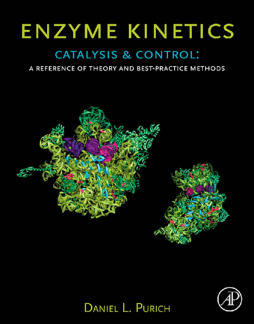
Additional Information
Book Details
Abstract
Far more than a comprehensive treatise on initial-rate and fast-reaction kinetics, this one-of-a-kind desk reference places enzyme science in the fuller context of the organic, inorganic, and physical chemical processes occurring within enzyme active sites. Drawing on 2600 references, Enzyme Kinetics: Catalysis & Control develops all the kinetic tools needed to define enzyme catalysis, spanning the entire spectrum (from the basics of chemical kinetics and practical advice on rate measurement, to the very latest work on single-molecule kinetics and mechanoenzyme force generation), while also focusing on the persuasive power of kinetic isotope effects, the design of high-potency drugs, and the behavior of regulatory enzymes.
- Historical analysis of kinetic principles including advanced enzyme science
- Provides both theoretical and practical measurements tools
- Coverage of single molecular kinetics
- Examination of force generation mechanisms
- Discussion of organic and inorganic enzyme reactions
"…this is an excellent book. It is difficult to pick it up without finding something new, interesting, and useful. The breadth of coverage and the author’s familiarity with disparate topics are impressive, and the references both to published work and to webbased resources are up to date so that one can jump into the primary literature as necessary." --Catal Lett, 2012, Volume 142
"One of the great strengths of this book is that the voice of the author comes through on every page. He does not simply list different methods for rate equation derivation, for example, but comments on the situations to which each is best suited. Chapter One includes a scolding of the Nobel Prize committee for overlooking Britton Chance’s contributions to science. Critical evaluations of published experimental data and alternative explanations are presented. Articulate arguments for the importance of continued research in enzymology are offered, and there is a thoughtful discussion of how pharmacologically useful compounds are developed. Above all, the people who have conducted the research upon which the book is based are recognized. The list of researchers who ‘‘made advances so notable that they personify the field’’ provides plenty of fodder for late night discussions at the Enzymes Gordon Conference. Whether one agrees with all of Purich’s judgements or not, their inclusion makes reading his book very enjoyable, and also documents his deep familiarity with and affection for the field…this is an excellent book. It is difficult to pick it up without finding something new, interesting, and useful. The breadth of coverage and the author’s familiarity with disparate topics are impressive, and the references both to published work and to web- based resources are up to date so that one can jump into the primary literature as necessary." --Springer, Science and Business Media, LLC
